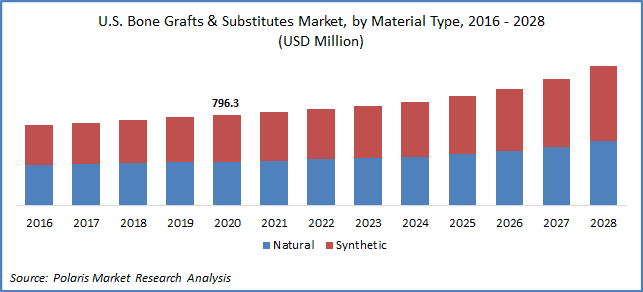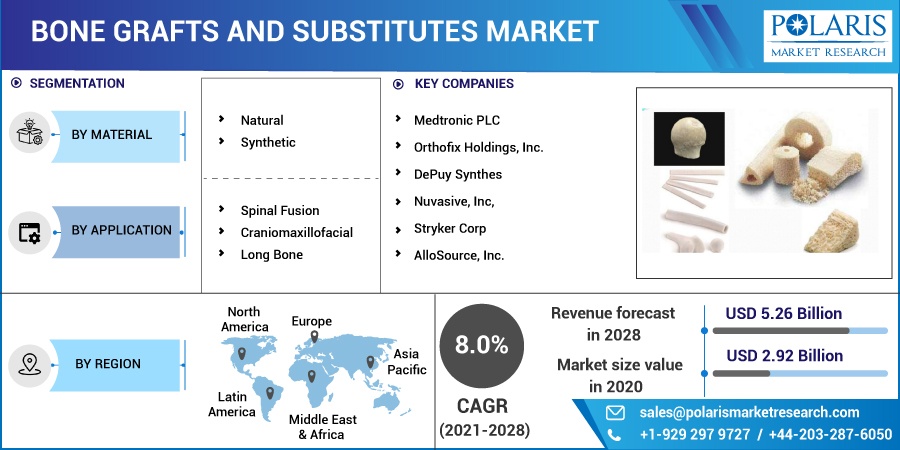
Bone Grafts and Substitutes Market Size, Share & Trends Analysis Report By Material Type (Natural, Synthetic); By Application Type (Spinal Fusion, Craniomaxillofacial, Long Bone); By Region - Segment Forecast, 2021 - 2028
- Published Date:Jun-2021
- Pages: 101
- Format: PDF
- Report ID: PM1650
- Base Year: 2020
- Historical Data: 2016-2019
Report Summary
The global bone grafts and substitutes market was valued at USD 2.92 billion in 2020 and is predicted to exhibit a CAGR of 8.0% over the forecast period. Bone grafts are the implantable materials that promote osseous restoration, bone healing and formation. This is done due to its osteoinductive, osteoconductive and osteogenic characteristics. Bone grafts and substitutes are commonly used for countless applications in orthopedic surgeries. The demand for bone grafts & substitutes are expected to increase because of the orthopedic issues caused by weakened bones. Thus, it is anticipated that the amount of orthopedic surgeries will increase with an increasing geriatric population which is more susceptible to orthopedic ailments. Thus, during the forecast period, the market is expected to experience significant demand. The growth of the worldwide bone grafts and substitutes market is influenced by variables such as development of biocompatible synthetic bone grafts, technological advances in the medical sector, increased incidence of musculoskeletal disorders, leading to a change from autografts to allografts, and resulting in increased dental bone grafts demand.

Know more about this report: request for sample pages
However elevated surgical costs and ethical problems linked to grafting processes are expected to limit the demand for bone grafts and substitutes. In contrast, it is anticipated that increased focus of important players on R&D operations in bone grafts & their substitutes and increased demand for orthopedic processes among geriatric population will provide profitable possibilities for market players in the future. High awareness of commercially accessible products, greater spending on healthcare and the accessibility of sophisticated healthcare infrastructure are the main factors contributing to its development. Expansion of healthcare facilities in developing countries is also projected to contribute the growth of this market over the forecast period.
This increase is due to occurrence of joint and bone disorders. In addition to this, these substitutes are used in diverse applications such as post-traumatic skeletal conditions, bone substitutes and many other bone-related problems. Moreover, development of innovative products and improvement in bone graft materials have increased the market growth. There has been a significant increase in the necessity of bone grafts for spinal fusion, due to rise in occurrence of spinal disorders and presence of an extensive range of products for spinal fusion.
Tricalcium phosphate and demineralized bone matrix are the examples of bone grafts & substitutes that work as graft extenders that is capable of substituting the necessity of autograft in spinal fusion. Autographs are best suited spinal fusion grafts; however, to some extent, the danger of chronic pain decreases their use. In addition, increased prevalence of patients with rheumatoid arthritis, osteoarthritis, and other joint illnesses has fueled demand for joint reconstruction processes. Specialized products such as structural bone grafts and vascularized free bone grafts which also includes femoral head grafts, which have further enhanced the use of bone grafts in joint reconstruction applications. Expansion in product portfolio is one of the major strategies adopted by the key players in this market.
 Know more about this report: request for sample pages
Know more about this report: request for sample pages
Bone Grafts and Substitutes Market Report Scope
The market is primarily segmented on the basis of material, application and geographic region.
|
By Material |
By Application Type |
By Region |
|
|
|
Know more about this report: request for sample pages
Material Outlook
The bone grafts & substitutes market is divided into natural and synthetic type based on material. Natural material segment leads the market and is expected to retain its dominance over the forecast period. This is largely due to increase in availability of risk data. Increasing orthopedic disease incidence and increasing awareness of multiple bone graft substitute apps are anticipated to increase segment development. The increase in prevalence of bone and joint disorders have also contributed to the rise in demand for bone and grafts substitutes, thus driving the market growth.
Application Outlook
The market is segmented into craniomaxillofacial, long bone, and spinal fusion based on applications. Spinal fusion held the major share in the overall market and is anticipated to retain its dominance over the forecast period as well. Increase in geriatric population is anticipated to drive the growth of this market over the forecast period. In addition to this, increase in number of road accidents is also expected to fuel the growth of this industry over the forecast period. Major players have started signing tie ups with hospital facilities in order to maintain their uninterrupted supply. This in turn, is projected to help them gain major pie in the global market shares. In addition to this, increase in medical tourism across the globe is also anticipated to fuel the growth of this market over the forecast period.
Regional Outlook
In 2020, North America market held the major share in the global market. It is anticipated that developing Asia Pacific economies such as China, Japan, India, and Hong Kong will contribute to the region's market growth. The main driver of the Asia Pacific economy is booming medical tourism sector providing sophisticated healthcare facilities at affordable expenses. Developing countries do not have a gross annual income in order to spend on the development on new methods for treatment and diagnosis. However, improvement in the healthcare facilities is projected to drive the demand for this market over the forecast period. Technological advancements is also expected to fuel the growth of this market over the forecast period.
Competitive Landscape
Some of the main players include Medtronic PLC, Orthofix Holdings, Inc., DePuy Synthes, Nuvasive, Inc, Stryker Corp and AlloSource, Inc. Majority of the players have adopted the strategy of mergers and acquisitions in order to gain a competitive edge in the industry. In addition to this, the key players have also adopted the strategy of signing partnership agreements with suppliers so as to maintain the regular supplies. In addition to this, research and development has also been one of the major strategies adopted by the key players in this market so as to gain major share in the global market. Major players have started targeting the developing countries with less treatment devices and need for development.
License and Pricing
Purchase Report Sections
- Regional analysis
- Segmentation analysis
- Industry outlook
- Competitive landscape
Connect with experts
Suggested Report
- Brain Implants Market Share, Size, Trends, Industry Analysis Report, 2021 - 2028
- Offshore Wind Energy Market Share, Size, Trends, Industry Analysis Report, 2022 - 2030
- Lactic and Poly Lactic Acid Market Share, Size, Trends, Industry Analysis Report, 2022 - 2030
- Seaweed Protein Market Share, Size, Trends, Industry Analysis Report, 2021 - 2028
- Injection Molded Plastic Market Research Report, Size, Share & Forecast by 2020 - 2027

